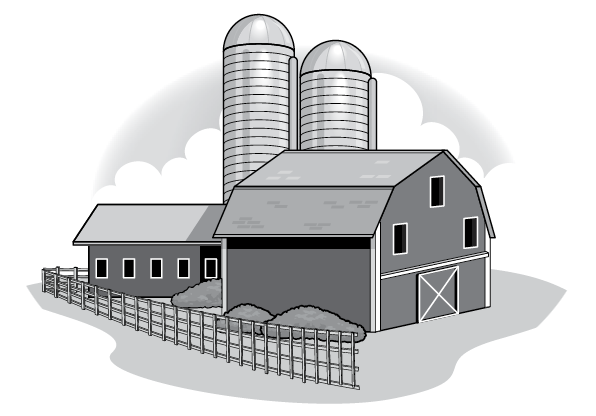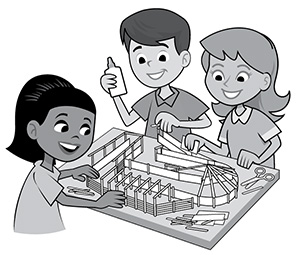 Relevancy and Engagement
learnaboutag.org
Relevancy and Engagement
learnaboutag.org
Build it Better
Grade Level
Purpose
Students investigate animal handling preferences, design a cattle corral system that is durable, efficient, and effective, and discover the skills needed to be an agricultural engineer. Grades 3-5
Estimated Time
Materials Needed
- Temple Grandin video
- Build It Better Design Plan handout, 1 per student
- Build It Better Design Resources handout, 1 per student
- Build It Better Design Grading Rubric, 1 per student
- Various Construction Materials (ruler, scissors, glue, poster board, craft sticks, construction paper, chenille stems, cardboard, cereal boxes, toothpicks, fabric, and more) for each group
Vocabulary
agricultural engineer: career in which people design farm machinery or help plan farm structures
behavior: the way in which an animal acts in response to a particular situation or stimulus
environment: the surroundings or conditions in which a person, animal, or plant lives or operates
handling: the manner in which an animal is treated
livestock: farm animals (such as cows, horses, and pigs) that are kept, raised, and used by people
well-being: the contentment of an animal measured by indicators including behavior, physiology, longevity, and reproduction
Did You Know?
- Temple Grandin has done extensive work on the design of handling facilities and has worked with companies worldwide—from the United States and Canada to Europe, Mexico, Australia, New Zealand, and other countries.1
- Today, half the cattle in the U.S. and Canada are handled in equipment Temple Grandin designed for meat processing plants.1
- Agricultural engineers help design methods of farming that decrease labor; therefore, increasing a farmer's ability to produce food.2
Background Agricultural Connections
This lesson is one in a series of five related lessons to promote the development of STEM abilities and critical thinking skills, while fostering an appreciation for the people involved in livestock production. For more information about what STEM is, why it's important, and how it can be implemented in your classroom, watch the video, What is STEM? The curriculum includes real-life challenges for students to investigate, inquiry-based labs, and opportunities to plan and construct models. Featured careers include:
- Animal Physiologist: Significant Surroundings
- Agricultural Engineer: Build it Better
- Animal Geneticist: Roll of the Genes
- Animal Nutritionist: Got Guts?
- Range Manager: Homes on the Range
Livestock can be difficult to move and direct. Many animals will not move forward if they are fearful of something they see, hear, or smell. Removing these distractions can greatly reduce animal handling problems. If animals feel safe in their environment and are relaxed and comfortable with the handler, they often move with little or no force.
The stress caused by poor handling environments has a negative impact on animals—it lowers livestock productivity, diminishes weight gain, reduces reproductive performance, and decreases the animal’s ability to fight disease. By understanding the behavior of livestock and designing environments that keep animals calm, livestock producers can greatly reduce animal stress. Significant work has been done by Colorado State University professor, Temple Grandin. She has made advancements in animal handling practices by researching how livestock perceive their environment and by designing livestock facilities that help keep animals calm.
Agricultural engineers have an important role in designing livestock facilities. They work with animal specialists and apply basic science and engineering principles to design solutions to challenges in livestock production. In general, agricultural engineers may design agricultural machinery and facilities, such as tractors and their implements, animal housing and handling facilities, irrigation and drainage systems, and soil conservation measures. In this lesson, students act as agricultural engineers by investigating animal handling preferences and designing a corral system that is durable, efficient, and effective in moving cattle.
Refer to the Answers to Commonly Asked Questions for more background information.
Engage
- Discuss with your students the following vocabulary words: well-being, environment, behavior, and livestock.
- Ask your students the following questions and lead a class discussion:
- What are some elements of animal welfare that should be considered when caring for animals? (Their necessities of life such as food, water, and shelter must be met.)
- What are the benefits to the farmer for having calm and content animals? What are the benefits to the consumer? (Calm animals are easier for the farmer to work with and generally produce more milk, meat, or eggs.)
- Inform your students that in this lesson, they will:
- Investigate animal handling preferences.
- Use online resources to research solutions to real-life problems.
- Plan and construct models.
- Design a cattle corral system that is durable, efficient, and effective.
- Learn about the skills needed to be an agricultural engineer.
Explore and Explain
- Help students start thinking like engineers by sharing this scenario:
- Maxine has an aging German shepherd named Frankie. Maxine needs to take Frankie to the veterinarian for his annual check-up. Since Frankie has gotten older, he can no longer get into Maxine’s truck independently. Unfortunately, Maxine broke her arm in a skiing accident last week and cannot lift him. It’s 9:45 and Maxine needs to think of a quick, safe, and efficient way to load Frankie into the truck for his 10 o’clock appointment. Put your engineering thinking cap on and let’s solve the problem!
- Brainstorm and record student ideas for loading Frankie into the truck. Remind students to think about keeping Frankie calm and safe while accomplishing the desired goal. Tell students that agricultural engineers apply basic science and engineering principles to design solutions to challenges in agricultural production. Highlight the responsibilities and skills of an agricultural engineer:
- Agricultural engineers may design agricultural machinery and facilities using drawings and models.
- Agricultural engineers use their knowledge and skills to solve real-world problems.
- Agricultural engineers need to be creative with the ability to envision new designs such as tractors and their implements, livestock handling systems, irrigation systems, and animal housing.
- Agricultural engineers must understand science and engineering concepts
- Tell students that they will be designing a corral system for cattle. Temple Grandin is a legend in the world of animal agriculture. She is known for her extraordinary understanding of the animal mind which has assisted her in designing animal handling systems—especially in cattle production. Temple Grandin gives credit to her autism, a condition that makes social interactions with other people challenging, for helping her understand how animals think and respond to their environment.
- Show the first minute and 40 seconds of a video that introduces Temple Grandin and her work. There are also a variety of videos available on the Temple Grandin YouTube channel. Grandin also improved slaughterhouse design, so you may wish to filter which video students watch.
- Review the Build It Better Design Plan handout with the class. The objective of the project is to design a model livestock corral and alley way for loading livestock onto trucks for transportation. The goal of your design is to keep the animals calm and safe. Your group will be graded on the effectiveness, efficiency, and durability of your design.
- As groups research and plan their design, they should record their progress on the Build It Better Design Plan handout. Each group must have teacher approval for their plan before starting construction. Introduce students to the available construction materials and divide students into groups.
- Once students have completed their models, groups will present their design to the class in a three-to-five-minute presentation. Students should highlight research findings, design characteristics, modifications, and their construction procedure. You may wish to grade the models using the Build It Better Design Grading Rubric or have students complete the rubric to grade their peers.
- Conclude the lesson by discussing the reflection questions on the Build It Better Design Plan handout.
Variation:
- Instead of creating a three-dimensional model, students can create a three-dimensional sketch using an online program, such as SketchUp.
- Distribute graph paper and challenge students to create a scaled diagram of their design.
- If students are not yet comfortable researching topics online, review the recommended resources prior to the lesson and print out specific documents that will help them identify design characteristics. Otherwise, teachers may use an LCD projector or SMART Board™ to demonstrate how to search the Web and identify important information.
- Challenge advanced students by giving them specific information such as type of truck, age, size or gender of cattle, and the distance between the animal housing and loading area.

ELL Adaptations:
- This lesson employs group work and cooperative learning. These activities provide opportunities for students to exchange, write, and present ideas.
- Identify the origin of lesson-specific words such as corral, humane, model, durable, implement, and effective. Knowledge of Greek and Latin prefixes, suffixes, and roots can greatly enhance student understanding of engineering terms and facilitate a better understanding of English.
Elaborate
-
Have students research the educational background and skills required to be an agricultural engineer.
-
Learn more about livestock facilities by visiting a local ranch, auction yard, or feedlot. Ask your tour guide to explain how their facilities keep animals calm and safe. If appropriate, have students employ Temple Grandin’s unique way of thinking by moving through the system to understand the animal’s perspective.
-
Further explore the contributions of Temple Grandin by watching the full-length film, Temple Grandin (2010, PG). As students watch the movie, have them record the challenges and successes she encounters as she designs facilities for animals.
-
Invite a local rancher to your class to discuss their livestock facilities. Ask the rancher to share a diagram of their corral and identify areas that are working well, and areas that could be improved. Your county Farm Bureau may be able to connect you to a local rancher.
Evaluate
After conducting these activities, review and summarize the following key concepts:
- Farmers and ranchers care for their animals by providing food, water, and shelter to keep them comfortable.
- Advances in technology decrease the labor necessary to produce our food on farms. Agricultural engineers develop and design these tools and machines.
- Agricultural engineers develop many types of tools and machines to use on farms. Some are simple such as a specific type of gate or animal feeder. Others are very complex machines such as tractors and harvesters.
- Ethics are a belief of what is right and what is wrong. Ethics guide the decisions of farmers in ranchers in raising animals to produce food and fiber.
Acknowledgements
This lesson was funded in 2012 by the United States Department of Agriculture’s National Institute of Food and Agriculture through the Secondary Education, Two-Year Postsecondary Education, and Agriculture in the K-12 Classroom Challenge Grants Program (SPECA). Graphics submitted by California Foundation for Agriculture in the Classroom.
Executive Director: Judy Culbertson
Illustrator: Erik Davison
Layout and Design: Nina Danner